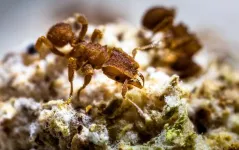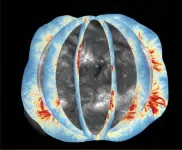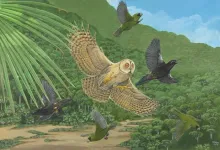(Press-News.org) SAN ANTONIO, Oct. 3, 2024 – The School of Dentistry at The University of Texas Health Science Center at San Antonio (UT Health San Antonio) earned the first National Institutes of Health grant under its new Center for Pain Therapeutics and Addiction Research, addressing pain in patients with head and neck carcinoma.
The nearly $600,000 grant by the NIH’s National Institute of Dental and Craniofacial Research will address this critical pain issue that significantly impairs quality of life. Many head and neck carcinoma patients require opiate pain management, but tolerance develops quickly, requiring new pain relief approaches.
“It is often very difficult to treat pain from oral cancer with available medications due to limited effectiveness or rapid development of tolerance,” said Shivani Ruparel, PhD, associate professor of endodontics at the UT Health San Antonio School of Dentistry, and the grant’s recipient and principal investigator. “We propose a novel mechanism of oral cancer pain that will provide knowledge for future research at developing drugs for not only pain management but also cancer treatment.”
The Center for Pain Therapeutics and Addiction Research, started in June this year, represents a transformative multidisciplinary approach to decrease pain and addiction. It focuses on both the mechanisms of pain and therapies to reduce or block its transmission, whether oral-facial or other regions of the body.
Therapies include novel, non-addictive medications, diet/nutritional modification and alternative therapies.
“This important NIH grant will support the groundbreaking research of Dr. Shivani Ruparel who is leading efforts towards novel mechanisms of orofacial pain and its treatment,” said Kenneth M. Hargreaves, DDS, PhD, professor of endodontics at the UT Health San Antonio School of Dentistry and inaugural director of its Center for Pain Therapeutics and Addiction Research. “By expanding our knowledge of pain biology, we can leverage these findings into tomorrow’s new medications.”
Targeting oral pain mechanisms
Pain is the No. 1 symptom of oral cancer patients that makes them go to the doctor. They experience pain as soon as a tumor develops in the oral cavity, and it increases as the tumor progresses. Therefore, these patients go through pain throughout the course of the disease that adds so much more to the burden of having cancer.
Unfortunately, pain management in these patients is not adequate because of limited treatment options available. This new study seeks to better understand the mechanisms of oral cancer pain to develop novel analgesics.
Tyrosine kinase receptors, a group of proteins found on the surface of cells important in many cell functions, have gained attention due to the emergence of small-molecule inhibitors for cancer treatment. Brain-derived neurotrophic factor, a protein vital for cognitive performance, together with its tyrosine kinase receptor are known to be overexpressed in oral tumors and implicated in cancer progression.
Ruparel’s team of researchers for the first time demonstrated that this pathway not only promotes tumor progression but also drives pain produced from the tumor at the very site of tumor growth. They have shown that brain-derived neurotrophic factor released from oral squamous cell carcinoma cells influences pain transmission, which can be reversed by inhibiting its receptor locally.
This indicates that this receptor potentially can be targeted to treat oral cancer pain without causing side effects typically observed with centrally acting drugs such as opioids.
Their preliminary data suggests that the truncated receptor is a predominant isoform or protein type in trigeminal sensory neurons that send pain signals for the head and face, as well as in oral squamous cell carcinoma cells, and is involved in oral cancer pain regulation.
Accordingly, the researchers aim to investigate the receptor’s role in sensory neurons and its impact on pain behaviors, neuronal plasticity and gene expression. And they will examine whether that receptor derived from oral squamous cell carcinoma cells regulates pain-associated changes in the tumor microenvironment by assessing immune cell profiles, transcriptomic changes and single-cell analysis in tongue tumors.
“This study's relevance lies in its potential to uncover novel therapeutic targets for managing oral cancer-induced pain and improving patients' quality of life,” Ruparel said.
“Specifically, we propose to study the role of the truncated tyrosine kinase receptor isoform of the brain-derived neurotrophic factor in mediating pain at the site of tumor development,” she said. “Given that this isoform contributes to tumor progression, targeting this receptor signaling can prove to be effective therapy for cancer-induced pain as well as tumor progression.”
The research has broad implications.
“Dr. Shivani Ruparel’s research addresses the critical need of pain management for those suffering from oral cancer,” said Peter M. Loomer, DDS, PhD, MBA, professor and dean of the UT Health San Antonio School of Dentistry. “Oral cancer is a significant health issue in South Texas, and Dr. Ruparel works towards improving the quality of life of those suffering from this devastating disease.”
The University of Texas Health Science Center at San Antonio (UT Health San Antonio), a primary driver of San Antonio’s $44.1 billion health care and biosciences sector, is the largest academic research institution in South Texas with an annual research portfolio of $413 million. Driving substantial economic impact with its six professional schools, a diverse workforce of more than 8,500, an annual expense budget of $1.46 billion and clinical practices that provide 2.6 million patient visits each year, UT Health San Antonio plans to add more than 1,500 higher-wage jobs over the next five years to serve San Antonio, Bexar County and South Texas. To learn about the many ways “We make lives better®,” visit UTHealthSA.org.
The UT Health San Antonio School of Dentistry offers 18 degrees and programs in both dentistry and dental hygiene, world-renown faculty educators, a diverse student population, state-of-the-art clinical facilities and a distinguished research enterprise. Departments include comprehensive dentistry, developmental dentistry, endodontics, periodontics, and oral and maxillofacial surgery. Scientists collaborate with clinicians and research teams worldwide, and work across multiple medical and dental disciplines to find new treatments, advancing knowledge of oral health, biomaterials, cancer, pain and more. To learn more, visit https://www.uthscsa.edu/academics/dental.
Stay connected with The University of Texas Health Science Center at San Antonio on Facebook, Twitter, LinkedIn, Instagram and YouTube.
END
UT Health San Antonio School of Dentistry earns first NIH grant under new center for pain therapeutics and addiction research
Nearly $600,000 award will address pain from head and neck carcinoma
2024-10-03
ELSE PRESS RELEASES FROM THIS DATE:
Do MPH programs prepare graduates for employment in today's market? Mostly yes, but who is hiring may be surprising
2024-10-03
Public health degree programs provide key competencies demanded by employers, but graduate employability could be improved by using more real-time data from employer job postings, according to a new study at Columbia University Mailman School of Public Health. This could help public health schools and programs ensure that graduates obtain specific technical skills listed in job postings, meet current employer needs, and prepare graduates for the demands of today’s labor market. The findings are published in the American Journal of Public Health.
The competencies required for the ...
New article provides orientation to using implementation science in policing
2024-10-03
Since the 2020 murder by Minneapolis police of George Floyd brought nationwide calls for change amid concerns that prevailing practices were not grounded in evidence and created harm, policing has been in turmoil. Implementation science (IS) involves integrating effective and evidence-based innovations into routine practice in fields like health care. Yet despite its potential, IS—and specifically, evidence-based policing (EBP)—remain vastly understudied and unused in police settings. In a new article, researchers provide an orientation to these issues ...
Three beer-related discoveries to celebrate Oktoberfest
2024-10-03
Frothy or smooth, bitter or sweet, light or dark: There’s a beer for most palates. As people around the world pour over the best brews at Oktoberfest celebrations or ferment about their favorite fall-themed beers, three papers published in ACS journals crack open new insights into these beverages. And if you’re hop-ing to conduct studies to find which beer is good for what ales you, please drink responsibly. Reporters can request free access to these papers by emailing newsroom@acs.org.
Coriander’s origin changes beer flavor. Just like simmering a stew, brewing a beer with herbs and spices can enhance its flavor. A study in ACS Food Science ...
AAAS launches user research project to inform the new AAAS.org
2024-10-03
Washington, D.C. — The American Association for the Advancement of Science, one of the world’s largest general scientific societies and publisher of the Science family of journals, announces an external research project to help the organization reimagine AAAS.org as part of a website overhaul project, which recently kicked off. AAAS is seeking input from its key audiences, including reporters and public information officers, to better align the experience and content of the website. As AAAS embarks on the next ...
In odd galaxy, NASA's Webb finds potential missing link to first stars
2024-10-03
Looking deep into the early universe with NASA’s James Webb Space Telescope, astronomers have found something unprecedented: a galaxy with an odd light signature, which they attribute to its gas outshining its stars. Found approximately one billion years after the big bang, galaxy GS-NDG-9422 (9422) may be a missing-link phase of galactic evolution between the universe’s first stars and familiar, well-established galaxies.
“My first thought in looking at the galaxy’s spectrum was, ‘that’s weird,’ which is ...
Adding beans and pulses can lead to improved shortfall nutrient intakes and a higher diet quality in American adults
2024-10-03
Moscow, Idaho, October 3, 2024: New research showing the association between greater bean and pulse consumption and improved shortfall nutrient intakes and a higher diet quality in American adults will be presented during the Academy of Nutrition and Dietetics (the Academy) Food & Nutrition Conference & Expo (FNCE) 2024 in Minneapolis, MN. The poster session is scheduled for Tuesday, October 8, 2024, from 10:45 – 11:45 AM CT at the Minneapolis Convention Center.
Researchers assessed the effect of increased bean and pulse consumption, in the typical US dietary pattern, on shortfall ...
What happens in the brain when a person with schizophrenia “hears voices”?
2024-10-03
Auditory hallucinations are likely the result of abnormalities in two brain processes: a “broken” corollary discharge that fails to suppress self-generated sounds, and a “noisy” efference copy that makes the brain hear these sounds more intensely than it should. That is the conclusion of a new study published October 3rd in the open-access journal PLOS Biology by Xing Tian, of New York University Shanghai, China, and colleagues.
Patients with certain mental disorders, including schizophrenia, often hear voices in the absence of sound. Patients may fail to distinguish between their ...
Ant agriculture began 66 million years ago in the aftermath of the asteroid that doomed the dinosaurs
2024-10-03
When humans began farming crops thousands of years ago, agriculture had already been around for millions of years. In fact, several animal lineages have been growing their own food since long before humans evolved as a species.
According to a new study, colonies of ants began farming fungi when an asteroid struck Earth 66 million years ago. This impact caused a global mass extinction but also created ideal conditions for fungi to thrive. Innovative ants began cultivating the fungi, creating an evolutionary partnership that became even more tightly intertwined 27 million years ago and continues to this day.
In a paper published today, Oct. 3, in the journal Science, scientists at the Smithsonian’s ...
A new era of solar observation
2024-10-03
EMBARGOED: Not for Release Until 2:00 pm U.S. Eastern Time Thursday, 3 October 2024.
A new era of solar observation
International team produces global maps of coronal magnetic field
Contacts:
Audrey Merket, NSF NCAR and UCAR Science Writer and Public Information Officer
amerket@ucar.edu
303-497-8293
David Hosansky, NSF NCAR and UCAR Manager of Media Relations
hosansky@ucar.edu
720-470-2073
For the first time, scientists have taken near-daily measurements of the Sun’s global coronal magnetic field, a region of the Sun that has only been observed irregularly in the past. The resulting observations ...
The true global impact of species-loss caused by humans is far greater than expected – new study reveals
2024-10-03
The extinction of hundreds of bird species caused by humans over the last 130,000 years has has led to substantial reductions in avian functional diversity – a measure of the range of different roles and functions that birds undertake within the environment –
and resulted in the loss of approximately 3 billion years of unique evolutionary history, according to a new study published today in Science.
Whilst humans have been driving a global erosion of species richness for millennia, the consequences of past extinctions for other dimensions of biodiversity are poorly known. ...
LAST 30 PRESS RELEASES:
Anthropologists offer new evidence of bipedalism in long-debated fossil discovery
Safer receipt paper from wood
Dosage-sensitive genes suggest no whole-genome duplications in ancestral angiosperm
First ancient human herpesvirus genomes document their deep history with humans
Why Some Bacteria Survive Antibiotics and How to Stop Them - New study reveals that bacteria can survive antibiotic treatment through two fundamentally different “shutdown modes”
UCLA study links scar healing to dangerous placenta condition
CHANGE-seq-BE finds off-target changes in the genome from base editors
The Journal of Nuclear Medicine Ahead-of-Print Tip Sheet: January 2, 2026
Delayed or absent first dose of measles, mumps, and rubella vaccination
Trends in US preterm birth rates by household income and race and ethnicity
Study identifies potential biomarker linked to progression and brain inflammation in multiple sclerosis
Many mothers in Norway do not show up for postnatal check-ups
Researchers want to find out why quick clay is so unstable
Superradiant spins show teamwork at the quantum scale
Cleveland Clinic Research links tumor bacteria to immunotherapy resistance in head and neck cancer
First Editorial of 2026: Resisting AI slop
Joint ground- and space-based observations reveal Saturn-mass rogue planet
Inheritable genetic variant offers protection against blood cancer risk and progression
Pigs settled Pacific islands alongside early human voyagers
A Coral reef’s daily pulse reshapes microbes in surrounding waters
EAST Tokamak experiments exceed plasma density limit, offering new approach to fusion ignition
Groundbreaking discovery reveals Africa’s oldest cremation pyre and complex ritual practices
First breathing ‘lung-on-chip’ developed using genetically identical cells
How people moved pigs across the Pacific
Interaction of climate change and human activity and its impact on plant diversity in Qinghai-Tibet plateau
From addressing uncertainty to national strategy: an interpretation of Professor Lim Siong Guan’s views
Clinical trials on AI language model use in digestive healthcare
Scientists improve robotic visual–inertial trajectory localization accuracy using cross-modal interaction and selection techniques
Correlation between cancer cachexia and immune-related adverse events in HCC
Human adipose tissue: a new source for functional organoids
[Press-News.org] UT Health San Antonio School of Dentistry earns first NIH grant under new center for pain therapeutics and addiction researchNearly $600,000 award will address pain from head and neck carcinoma






